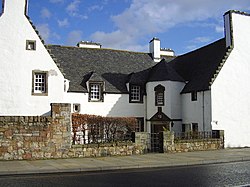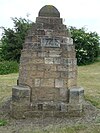Prestonpans
| Prestonpans | |
| East Lothian | |
|---|---|
 Hamilton House, Prestonpans | |
| Location | |
| Grid reference: | NT401745 |
| Location: | 55°57’35"N, 2°57’40"W |
| Data | |
| Population: | 7,153 (2001) |
| Post town: | Prestonpans |
| Postcode: | EH32 |
| Dialling code: | 01875 |
| Local Government | |
| Council: | East Lothian |
| Parliamentary constituency: |
East Lothian |
Prestonpans is a small town in East Lothian, to the east of Edinburgh, which is a major influence all along the coast. Prestonpans is best known as the site of the 1745 Battle of Prestonpans in 1745.
The town has a history dating back to the 11th century and in its long life Prestonpans has gathered some impressive examples of historical architecture, such as the Preston Tower and the doocot and the local Mercat Cross, which is the only one of its kind which remains in its original form and location.
The town also has the dubious distinction of having been named "Scotland's Mural Town" as it has many wall murals, an odd form of civic adornment, reflecting the town's colourful past.
Contents
History
According to certain stories Prestonpans was originally founded in the 11th century by a traveller named Althamer, who became shipwrecked on the local beach/coastal area. Finding it impossible to get home, the survivors of the wreck decided to remain where they were and founded a settlement named Althamer in honour of their leader. Whether this story is true or not is a matter of opinion, however when the monks of Newbattle and Holyrood arrived in the district in 1184 there was already a settlement named 'Aldhammer' on the site of what is now Prestonpans. The monks gave the settlement their own name, Prieststown or Prieston. The latter part of the name is from local the salt making established by the monks, who dug salt pans on the sea shore. Thus the town became Salt Prieststown and Salt Preston, and finally Prestonpans.
One of the first post-Reformation churches was built in Prestonpans, in 1596, for and at the expense of the new minister, Reverend John Davidson[1]. The church was greatly remodelled in 1774. Ten years after the original building of the new church, Prestonpans became a Parish in its own right, having previously formed part of the Parish of Tranent.
Industry
Salt panning was a very important industry in the early history of Prestonpans. By the beginning of the 15th century there were ten salt works belonging to the town capable of producing between 800 and 900 bushels of salt per week. However, Prestonpans was not solely given up to that one industry; many others flourished in Prestonpans and contributed towards the town's growth. The discovery and mining of coal by the Newbattle monks in the early 13th century was arguably the first instance of coal mining in Britain. The mining of coal in Prestonpans began in the year 1210, and would continue for centuries.
Prestonpans at one time had sixteen breweries but as times have developed, none of those original breweries exist any longer. The oldest brewery in Prestonpans belonged to the Fowler family and was built in 1720. The Fowlers obtained it in 1756 and it was in production until the 1960s. The building was demolished in 1989 to make way for flats. There was a soap works in the town which at one time had an output of 90,000 lb a year, and also several potteries and brickworks.
The town was served, for several hundred years, by the harbour at nearby Prestoungrange, known as "Morison's Haven". Fishing boats sailed from the harbour and herring was the most important catch. The harvesting of oysters was a lucrative industry up to the early 20th century.
Battle of Prestonpans
The Battle of Prestonpans (also known as the Battle of Gladsmuir) was the first significant conflict in the second Jacobite Rising. The battle took place on 21 September 1745. The Jacobite army was raised in the Highlands for the cause of James Stuart, the "Old Pretender", son of the deposed King James VII and I, and was led by the Pretender's son Charles Edward Stuart ("the Young Pretender" or "Bonnie Prince Charlie").
At Prestonpans the Jacobites were faced by a corps of the army of King George II, commanded by Sir John Cope. They struck in the dawn, though a deep fog bank and took Cope by surprise; it was a victory for the Jacobites which greatly boosted their morale and allowed them to occupy Edinburgh; only the castle held out for the King.
A heavily mythologised version of the story entered art and legend. It gave rise to a song Hey Johnnie Cope, which Highland regiments have been known to play on the pipes, with the chorus:
Hey Johnnie Cope are you wauking yet,
Or are your drums a-beating yet?
If you were wauking I would wait,
Tae gang tae The Coals in the morning.
A memorial to the Battle of Prestonpans in the form of a modest stonemason-built cairn sits close to the battle site. An earlier (and tellingly, much larger and more impressive) monument to Colonel Gardiner, a government officer who was mortally wounded on the field of battle, was also erected in the 19th century near Bankton House where the Colonel lived. Each year on the anniversary of the battle, a Battlefield Walk is organised by local historians, and in September 2008 the Battle of Prestonpans 1745 Trust organised a symposium on local battlefields. A memorial in the parish church commemorates "John Stuart of Phisgul...barbarously murdered by four Highlanders near the end of the Battle".
Modern Prestonpans
The war memorial stands near the town centre but is slightly obscured by the flanking buildings. It is a fine sculpture of a Scots "Tommy" in bonnet and great coat by William Birnie Rhind, 1921.
Adjacent to the war memorial is a bronze plaque dedicated to the memory of those who lost their lives in the Spanish Civil War.
There is now no salt or mining industry in the area. The town has developed considerably over the last few years. New housing has been built on greenbelt and there is potential for more affordable housing in the town. There remains a thriving community spirit. A two-week festival in early summer links Prestonpans with neighbouring Cockenzie and Port Seton, called The Three Harbours Festival.
The Prestonpans Murals Trail has become popular over the last few years. In 2006 it hosted the town hosted the Global Murals Conference.
Prestonpans railway station is on the Edinburgh to North Berwick line.
Sport
- Cricket: Preston Village Cricket Club
- Football: Preston Athletic FC
- Rugby: Preston Lodge RFC
- Golf: The Royal Musselburgh Golf Club, the sixth-oldest golf club in the world
Outside links
- Prestongrange Industrial Heritage Museum – A local museum offering tours
- Preston Lodge High School – The secondary school for the area
- Profile of Prestonpans at Undiscovered Scotland
- Global Murals Conference Prestoungrange 2006
- Article, The Herald, 29 April 2008, Historic Scotland trying to protect Scotland's battlefields
- "Historic battlefields in Scotland threatened by lack of legal protection". The Times, 29 April 2008
References
- ↑ Buildings of Scotland: Lothian, by Colin McWilliam
- Edinburgh Evening News, 12 August 2006, article by Jim Gilchrist "Designs on their wall"
- The Herald, 1 June 2007, "Local festival illuminates Scotland's 'riviera' " by Sarah Unwin Jones
- The Scots Magazine, illustrated article on Prestonpans Murals trail
- Leaflet "Happy Walks in Prestonpans"
- Prestonpans Historical Society page showing photo of Press cutting about Murals Trail


